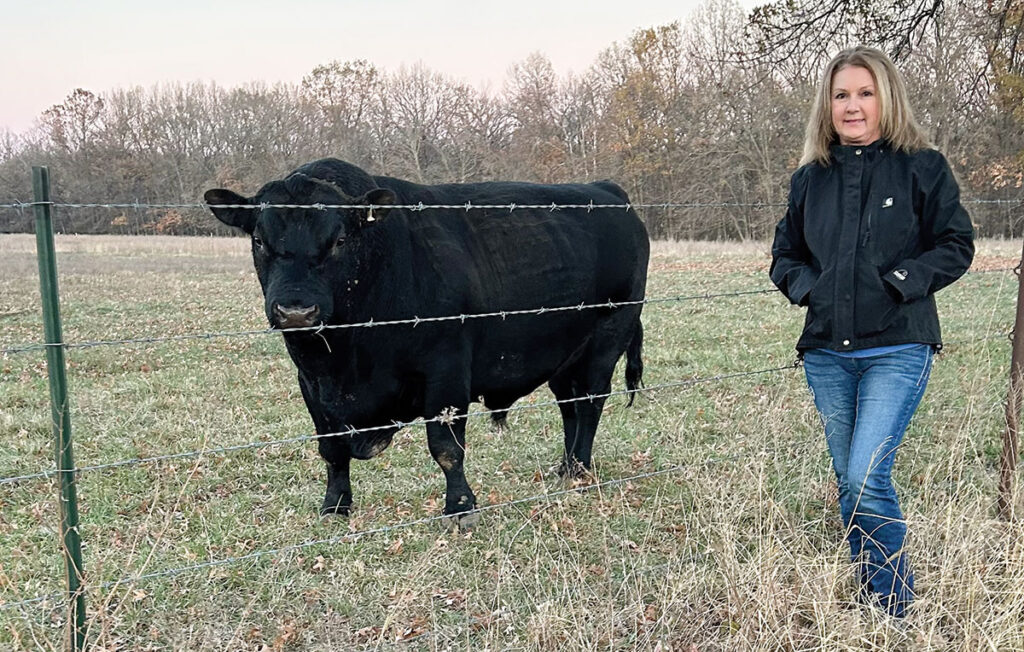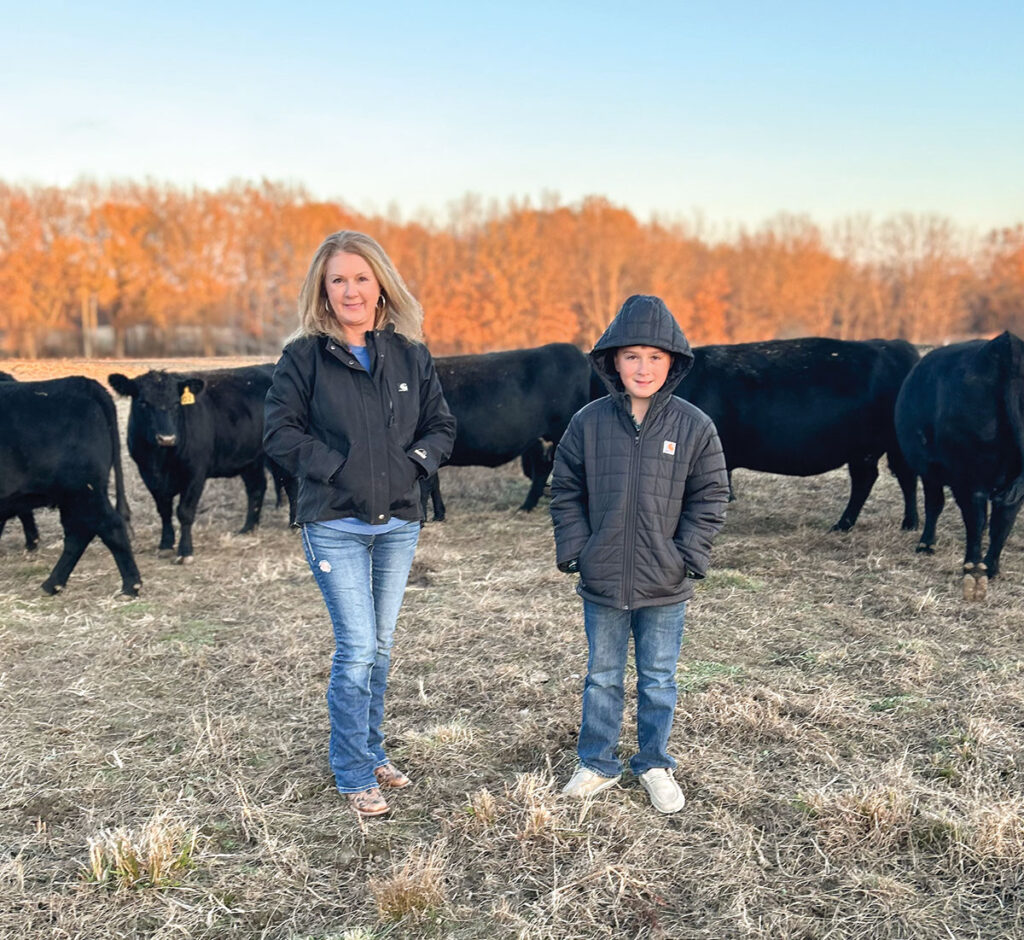
Susan Abbott began building an Angus herd with two heifers
SCHELL CITY, MO. – When Susan Abbott’s father, Elmer Abbott, brought Angus bulls to their herd, she was intrigued.
“I guess he saw that interest and wanted to spark it, so he told me he would buy my first two Angus cows, which were bred, and the rest was up to me,” Susan recalled. “I just kept saving heifers and growing it organically. It just kept building to what it is today.”
Susan, a ninth-generation farmer in St. Clair County, Mo., operates a 200-head herd near Schell City, Mo., on the same farm where she grew up. The first parcel of 90 acres came into Susan’s family in the 1830s, and Elmer grew the operation to about 1,600 acres. Susan’s family, including her husband Bob Lawson, son Judd Lawson, mother Marceline, and siblings Connie and Marcia, live on the farm. While every family member has a role on the farm, Susan’s is the cattle operation.
Abbott Angus includes a registered herd of about 47 head, a commercial herd bred by registered Angus bulls and a feedlot. Black-influenced bulls have bred the commercial herd for decades.
Susan appreciates the low-maintenance yet highly-productive traits of Angus.
“I don’t want something that has to be propped up with inputs,” she said. “We have the greatest occupation in the world; we can take sunshine and rain, grow grass and bring these cattle into harvest, so we want efficient harvesters. I want ones that get in there, do well, keep their weight and good condition, and don’t fall apart after calving. After the dry weather we’ve had this year, it lets you know where your cattle are, how hardy they are. I was glad to see my cattle maintained their condition.
“I like a moderate size and easy keepers. That natural fly resistance and good hair coat is a sign of good health. Usually, when you have those good hair coats, you don’t see the pestilences go to those cattle like you do on ones that are a little rougher-haired.”
Since the 1970s, the only females brought to the farm were the two original registered Angus heifers. The registered and commercial herds have grown through the retention of quality females and selective breeding. Quality females not retained for the Abbott breeding program are sold as replacement heifers, usually in groups of 15 to 20.
Bull sales are not a part of the Abbott marketing strategy, but Susan will develop two or three bulls a year for private sales.
The breeding program at Abbott Angus Farm is natural cover for both herds. Current sires with the commercial herd were purchased through Pharo Cattle Company.
“I’m a big fan of those,” Susan said. “I think they are developing bulls that create replacements and the type of cattle I want to raise.”
By going to natural breeding, Susan said they saved a great deal of time and labor.
“The old adage is to work smarter, not harder,” she said. “Just because the technology is there doesn’t mean we have to embrace it. We’re pretty happy with the bulls we have, and if they can go out there and do the job, I’m all for them doing it instead of me.”
Previously, the Abbott herds were both spring and fall calving, but it is now all fall calving.
“We were wearing ourselves slick doing chores all over at all these places, plus it wasn’t allowing the grass to rest,” Susan said. “We still have the purebred Angus herd separated, but we combined the spring and fall herds and have gone fall only. We wanted to wean once a year, and when we do the hauling for our beef customers, we do it through a season for about five, six months. We wanted to make sure we were loving the job and not chasing our tails. We wanted to calve on our best quality grass. In fescue country, we thought that was our best grass.”
The calving window is about 90 days, which allows them to have cattle finished at different intervals for the beef program.
“We try to haul six to 10 per load [to the processor],” Susan explained. “By spreading them out, we can allow them to reach their full potential.”
Beef sales are a significant market for Abbott Angus Farm. Steers remain on pasture until they are about a year old, then are brought into the feedlot and offered free-choice corn, which Susan said improves marbling and gives the meat a “buttery flavor.” Calves remain in the feedlot until they reach 1,300 pounds. About 75 to 90 head are finished annually and sold directly to customers as wholes, halves, quarters or bundles.

“We have people from Arkansas, Kansas, Oklahoma and Missouri who will drive to pick up beef at local processors,” Susan said. “We work to offer a quality product and sell the same beef I would offer to my family.”
She sees beef sales as an opportunity to educate consumers as well.
“There are no silly questions,” Susan said. “I want them to feel good and have the whole package of knowing the farmer and how their beef was raised. People are more health conscious and like to know where their food is coming from, how it was raised, and they want to know where it was sourced. I think consumers often go to the grocery store and see meat is sometimes coming from other countries; they don’t get a relationship with that producer or farmer. But if they can pick up the phone and call you, and you try to answer their questions, that creates a connection.”
Cattle in the beef program receive a single vaccination against blackleg, but no other vaccines or dewormer, unless needed.
Using low-stress handling methods is part of raising quality beef for Abbott Angus Farm.
“We don’t use hotshots on our cattle, sticks or anything like that,” Susan said. “I like to keep everything peaceful and easy working, and it’s the same thing when we unload at the processors. No one is allowed to pick up a stick or hotshot because this is someone’s beef. I’m attentive to the details because I want a good quality product all the way through.”
Thanks to forage management through a rotational grazing system of about 300 acres, the herd typically grazes on stockpiles until February.
“Our forages are improved through better utilization,” Susan said. “Our pastures have a longer rest period, which lets the grass come back. We aren’t grazing it down short and have a bigger diversity. I see warm-season grasses in the seed bank starting to emerge more and just a variety of plants. It’s going to be better in the long run because of that variety of nutrition for the animal. Our fescue pastures are still predominant, but we try to mediate the endophyte with some legumes that we interseed in the winter.”
In addition to their fescue and grass-mixed hay, they also grow alfalfa to supplement the herd in the winter months. Cattle also receive minerals, which change based on the herd’s needs.
The Abbott family also has a row crop operation, growing about 500 acres of corn and soybeans, which is used to feed the Abbott herd.
Susan’s passion for the Angus breed may have started with two cows, but her love for the cattle industry goes back to her late father.
“As a kid, I have the memories of checking cows with him, back when you could stand up in the seat of the truck,” Susan said. “He was such a mentor to me. We were best friends, business partners and he was my hero. His love for farming was just infectious, and I think it transferred over to me, where it’s what I wanted to do. I like knowing that I am continuing a legacy.”
She is hopeful the legacy and the love for the cattle industry will pass on to her son Judd.
“He would be the 10th generation farmer and already has a few heifers,” Susan said.







